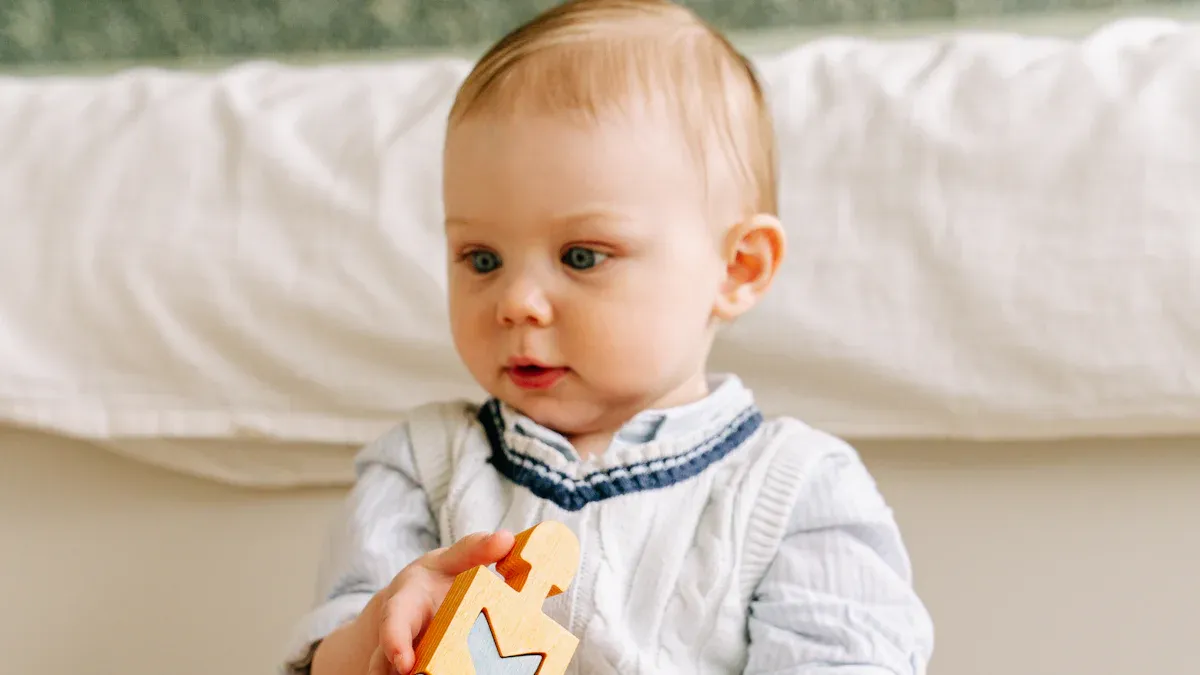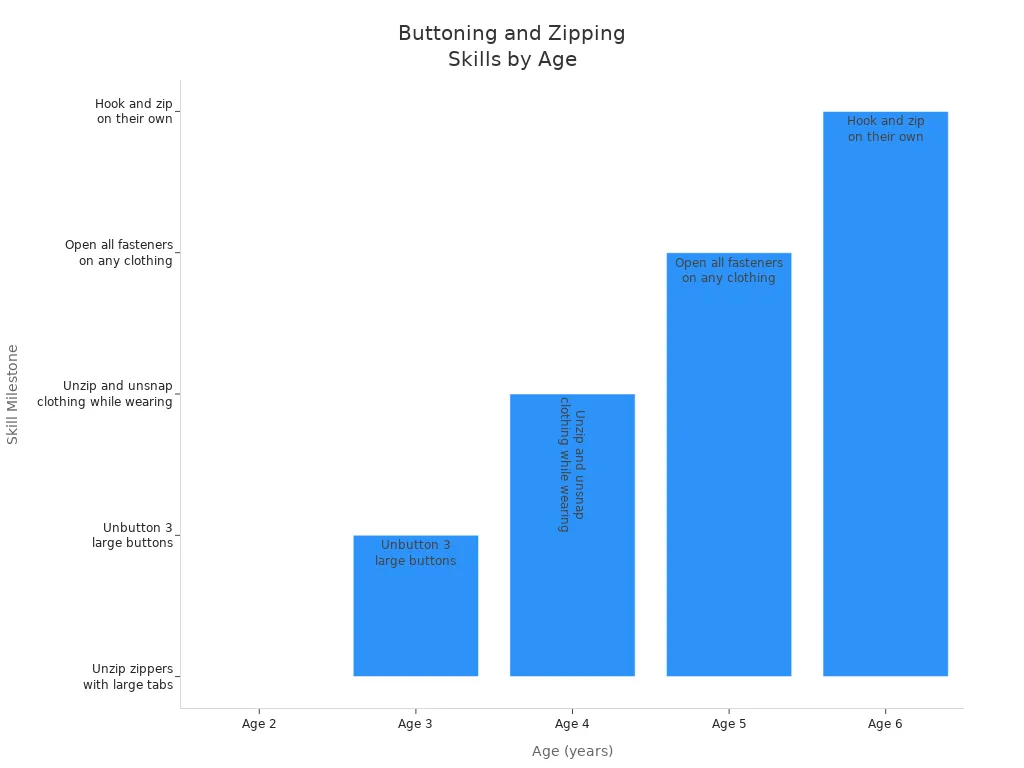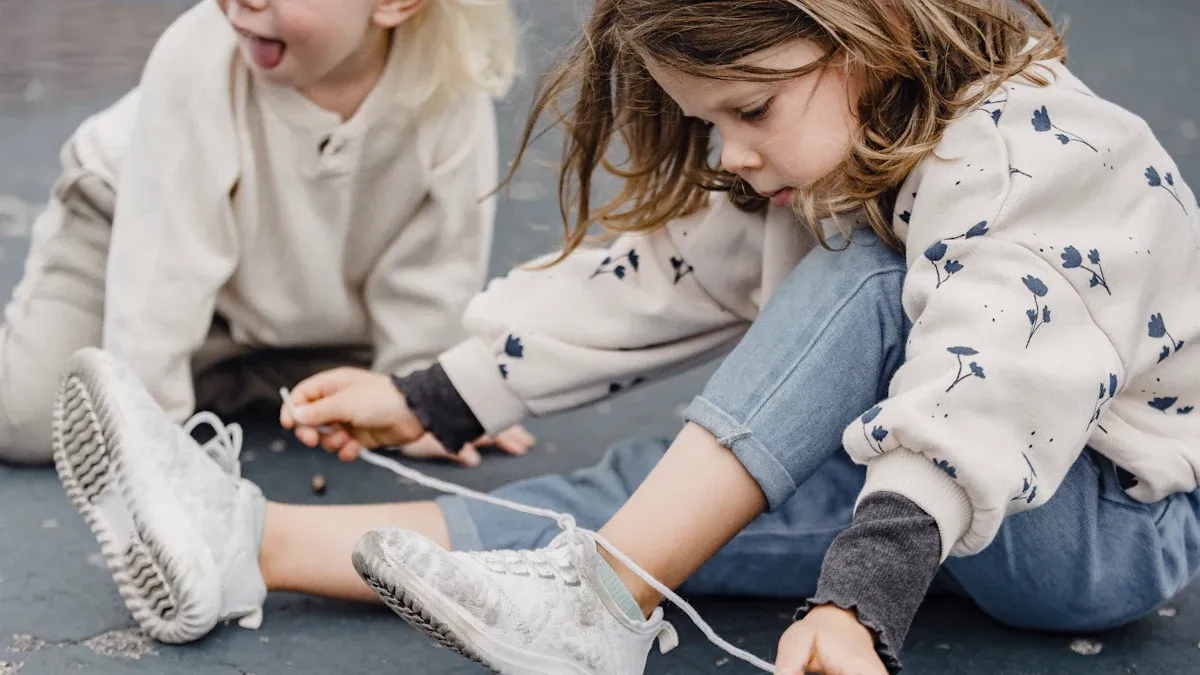When you wonder if your toddler is ready for buttons and zippers, focus on what you see every day. Skills like buttoning come after gross and fine motor abilities develop, not just with age.
|
Skill Order |
Development Stage |
|---|---|
|
Gross motor |
First |
|
Cognitive |
Next |
|
Fine motor |
Last |
Notice your child’s interest and how much they practice. Every child moves at their own pace. Spotting when your toddler is ready makes learning smoother and less stressful for both of you.
Key Takeaways
-
Look for signs your child wants to dress. If your toddler grabs buttons or zippers, they may be ready to learn. - Help them practice with simple clothes. Pick clothes with big buttons and zippers to help them feel confident and learn skills. - Cheer for every small win. Praising your child helps them feel good and makes them want to try more.
Why These Skills Matter
Independence
You probably notice your toddler wants to do things on their own. That’s a big step! When your child learns to button, zip, and tie laces, they start dressing themselves. This is more than just getting ready for the day. It’s about building independence. Kids who master self-dressing skills feel proud and confident. They can join in with friends and take care of themselves. You’ll see your child’s self-esteem grow as they celebrate small wins, like buttoning a shirt or zipping a jacket.
Tip: Let your toddler practice with easy clothes. Cheer them on when they try, even if it takes a few tries.
Here’s a quick look at the long-term benefits:
|
Benefit |
Description |
|---|---|
|
Independence |
Kids become more self-sufficient and ready for new challenges. |
|
Confidence |
Success with dressing boosts self-esteem and motivation. |
|
Social Skills |
Children fit in with peers and join group activities more easily. |
|
Development |
Fine and gross motor skills, coordination, and thinking improve. |
Fine Motor Growth
Buttoning and zipping aren’t just about getting dressed. These skills help your child’s hands and fingers get stronger and more coordinated. When your toddler uses both hands to zip a jacket or button a shirt, they build hand-eye coordination and motor planning. These tasks need practice and patience. You’ll notice your child’s fingers getting more nimble and their movements smoother over time. Fine motor growth sets the stage for other important skills, like writing, drawing, and using scissors.
-
Practicing buttons and zippers helps your child:
-
Develop strong fingers and hands
-
Improve hand-eye coordination
-
Learn to use both hands together
-
Remember: Every child learns at their own pace. Celebrate effort, not just results!
Signs Your Toddler Is Ready

Shows Interest
You might notice your child watching you closely as you get dressed or reaching for buttons on your shirt. Curiosity is a big clue that your toddler is ready to try new things. If your child asks to help with zippers or wants to pick out clothes with buttons, that’s a sign they want to learn. Sometimes, kids will even try to fasten their own jacket or play with snaps on toys. When you see this interest, you know they’re starting to build the motivation needed for learning self-dressing skills.
Tip: Offer clothes with large buttons or zippers. Let your child explore and practice during playtime.
Uses Both Hands
You’ll see progress when your child starts using both hands together. This skill shows up in daily routines. For example, your child might hold a book with one hand and turn pages with the other. During snack time, they may scoop food with one hand and hold the bowl with the other. Bath time can be a chance to splash with both hands or grab toys. When your toddler helps pull on socks or tries to zip up a jacket, they’re showing readiness for buttoning and zipping.
-
Activities that encourage two-hand use:
-
Diapering and dressing
-
Playing with toys in both hands
-
Using sippy cups with two handles
-
Turning pages in books
-
Pincer Grasp
The pincer grasp is a big step in fine motor development. You’ll see it when your child picks up small objects between their thumb and index finger. This skill usually starts around 9 to 12 months and gets stronger after the first year. By the time your toddler is ready for buttoning, they can pick up buttons, zip tabs, and even small snacks. You might notice them feeding themselves finger foods or using crayons to draw. These actions show they have the finger strength and control needed for dressing tasks.
|
Age Range |
Skill Developed |
|---|---|
|
9-12 months |
Basic pincer grasp developed |
|
Around 12 months |
Mature pincer grasp allowing precise manipulation |
|
Post 12 months |
Follows Directions
When your child listens and follows simple steps, you know they’re ready for more complex tasks. Buttoning and zipping need your child to remember what comes next. For example, you might say, “Hold the shirt, push the button through, then pull.” If your child can follow these steps, they’re showing the ability to sequence actions. This skill helps them become more independent and confident in dressing.
Note: Try giving your child two or three steps at a time. Watch how they respond and adjust your instructions as needed.
Focuses on Tasks
You’ll notice your toddler is ready when they can stick with a task for a few minutes. Maybe they try to zip up a jacket or button a shirt without giving up right away. Focus and patience are important for learning new skills. If your child gets frustrated but keeps trying, that’s a good sign. You can help by making practice fun and giving lots of encouragement.
Imitates Others
Kids love to copy what they see. If your child watches you button your shirt or zip your coat and then tries to do the same, they’re showing readiness. Imitation helps toddlers learn faster. They might also copy older siblings or friends during play. This builds confidence and helps them understand how things work.
-
Ways imitation helps:
-
Learning new skills by watching adults or older kids
-
Building independence through practice
-
Understanding themselves and their abilities
-
Pulls and Pushes
Pulling and pushing actions are early signs your toddler is ready for buttoning and zipping. You might see your child stringing beads, lacing cards, or passing buttons through buttonholes during play. These activities build the strength and coordination needed for fasteners. Start with toys and games, then move to real clothes with larger buttons and zippers.
-
Start Early: Use fine motor toys and play activities.
-
Pre-Fastener Activities: Try stringing beads and lacing cards.
-
Beginning Fastener Activities: Practice with button snakes and passing buttons through holes.
-
The Real Thing: Move to clothing with large buttons and zippers.
Buttoning and Zipping Skill Milestones
You might wonder when your toddler is ready for buttoning and zipping. Here’s a quick look at typical ages and skills, but remember every child is different.
|
Age |
Skills for Buttoning and Zipping |
|---|---|
|
2 |
Unzip zippers with large tabs; Pull a zipper up with help; Unbutton larger buttons (1 inch or more). |
|
3 |
Unbutton 3 large buttons, even if not in the exact order. |
|
4 |
Unzip and unsnap clothing while wearing it; Close the front snap; Button and unbutton while wearing a front-opening garment. |
|
5 |
Open all fasteners on any piece of clothing; Hook and zip up on their own. |
|
6 |
Can hook and zip on their own while wearing clothes. |

Remember: Some children reach these milestones earlier or later. Watch for signs your toddler is ready and celebrate every step.
Buttoning and Zipping Milestones

Buttoning Skills
You might wonder when your child will start buttoning and zipping on their own. Most toddlers begin learning to button and unbutton clothing around age 2. You’ll see progress as your child’s dexterity improves. Buttoning and zipping require more than just finger strength. Your child needs to use fine motor skills, think about what comes next, and understand how things fit together. At first, your toddler will probably unbutton large buttons before they can button them up. This is normal. Kids usually master unbuttoning before buttoning.
Here’s how buttoning skills often develop:
-
Around 2 years: Unbutton large buttons (about 1 inch or more)
-
2.5 to 3 years: Button three large buttons, even if not in order
-
3 to 4.5 years: Button and unbutton while wearing front-opening clothing
You’ll notice your child’s confidence grow as they practice. Celebrate each small step!
Zipping Skills
Zipping can be tricky for little hands. Most toddlers show interest in zipping between ages 2 and 3. You might see your child try to pull a zipper tab up while you hold the bottom. As their dexterity gets better, they’ll start zipping on their own. The order of skill development matters. Kids usually learn to unzip before they can zip up.
Check out this table for a quick look at how buttoning and zipping skills progress:
|
Age Range |
Skills Developed |
|---|---|
|
1.5-2 years |
Can unzip zippers with large tabs. |
|
|
Can pull a large zipper tab up if an adult holds it. |
|
2 years |
Can unbutton large buttons (1 inch or more). |
|
2.5-3 years |
Can button 3 large buttons, though not in order. |
|
2.5-3.5 years |
Can unzip and unsnap clothing while wearing it. |
|
3-4.5 years |
Can close the front snap on clothing. |
|
|
Can button and unbutton while wearing front-opening clothing. |
|
4.5-5 years |
Opens all fasteners on any piece of clothing. |
|
5-6 years |
Can hook and zip up on their own. |
Remember, every child moves at their own pace. Buttoning and zipping milestones are just guidelines. If your child takes longer, that’s okay. Keep encouraging practice and make it fun. You’ll see their zipping skills and dexterity improve with time.
If Not Ready
Build Fine Motor Skills
If your toddler cannot fasten buttons or zippers yet, you can help at home. Try activities that make their hands stronger. These also help with hand-eye coordination. You can use clothespins, coloring, or dough for practice. These tasks help your child grip and control their fingers. Therapy putty and pegboard games are good too. Painting or tong games can make practice fun. Here is a table with ideas you can try:
|
Activity |
Description |
|---|---|
|
Clothespins |
Enhances grip and dexterity. |
|
Coloring |
Improves hand control and coordination. |
|
Dough Activities |
Strengthens hand muscles and manipulation skills. |
|
Eye Dropper Activities |
Develops precision and control. |
|
Hole Punch Activities |
Encourages hand strength and coordination. |
|
Painting |
Fosters creativity while improving motor skills. |
|
Tong/Tweezer Activities |
Enhances grip and fine motor control. |
|
Therapy Putty Exercises |
Builds hand strength and dexterity. |
|
Pegboard Activities |
Improves hand-eye coordination. |
|
Push Pins/Golf Tees Activities |
Develops fine motor skills through manipulation. |
Encourage Practice
You can make learning to dress fun with easy clothes and games. Start with shirts that have big, bright buttons. Use jackets with large zippers. Add a keyring or ribbon to the zipper for better grip. Practice unbuttoning first. Then try buttoning from the bottom up. Use dolls or stuffed animals with fasteners for more practice. Busy boards and dressing frames are helpful too. Here are some toys and tools you might like:
|
Toy Type |
Description |
|---|---|
|
Velcro Dressing Boards |
Mimic dressing activities like buttoning and zipping, excellent for fine motor skills and independence. |
|
Dressing Frame Toddler |
A busy board that includes various fasteners like zippers and buttons, designed for educational play. |
You can also use a ribbon and plastic bread ties to act like zippers. Hold the ribbon tight and let your child slide the ties. This helps both hands work together and makes practice fun.
If your child has trouble with coordination or using both hands, talk to an occupational therapist. They can help with self help skills and give more support.
You will see that each child learns buttoning and zipping differently. Some kids learn fast, while others need more time. It is important to be patient and cheer them on. Celebrate every small success. Give high-fives, use a chart for milestones, or let your child choose their clothes. Here is a simple chart showing when kids often learn these skills:
|
Age Range |
Skills Developed |
|---|---|
|
1.5-2 years |
Unzip a zipper with a large tab |
|
2-3 years |
Button or unbutton big buttons; unzip a coat |
|
3-4 years |
Zip after someone starts it; use big buttons |
|
5-6 years |
Zip, unzip, button, and unbutton all sizes |
Make practice fun and happy. If you support your child, they will learn these skills when they are ready!
FAQ
How can you help your toddler learn to use buttons?
You can let your child practice with shirts or jackets that have big buttons. Try using toys or busy boards with buttons during playtime. Celebrate every small success!
What if your child gets frustrated with buttons?
Stay calm and encourage your child. You can break the task into steps. Use clothes with larger buttons first. Give lots of praise and make practice fun. 😊
Are there games that make buttons easier for toddlers?
Yes! You can play matching games with buttons. Try sorting buttons by color or size. Use button snakes or lacing cards. These activities build finger strength and confidence.









